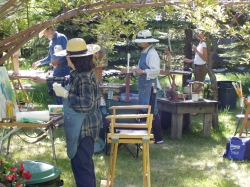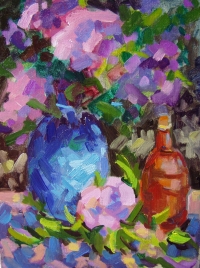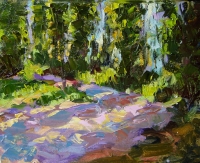What a beautiful day in Idaho! I arrived at Ovanes’ studio to find cheerful Vickie Reece (Ovanes’s assistant) had set up wonderful outdoor still lifes in the orchard surrounding his studio. They were perfect juxtapositions of shapes, colors and values. The dappled light from the fruit trees made the subject both challenging and inspiring.
 After we painted outdoors a while, Vickie invited us in for a demo in Ovanes’s studio. The first thing I noticed–other than the inspiring art on the walls–was his palette, filled with a full spectrum of colors piled high. I’m guessing there was about one full cup of each color!
After we painted outdoors a while, Vickie invited us in for a demo in Ovanes’s studio. The first thing I noticed–other than the inspiring art on the walls–was his palette, filled with a full spectrum of colors piled high. I’m guessing there was about one full cup of each color!
We were asked not to photograph in the studio, so I’ll do my best to describe his method.
PREPARATION:
- MEDIUM: 1/4 Linseed oil, remaining split of Gum Turpentine and Damar varnish (yes, it smells, work in a well ventilated room or better yet outdoors!). Ovanes explained the importance of this medium: to avoid muddy color, you need the under painting to dry quickly.
- CANVAS: three coats of acrylic Gesso. The more porous the better to absorb the toning and under-painting
- PAINT: Classic Artist’s Oils. Mix linseed oil as necessary to achieve a uniform consistency (of mayo).
The steps I describe below are my own interpretation of his process, Ovanes didn’t enumerate his process.
STEP 1: OUTLINE GENERAL SHAPES. Outline the big masses, paying attention to a pleasing distribution of positive and negative spaces.
STEP 2: TONE THE CANVAS. This is an interesting phase. He covers the white canvas completely with very thin washes of rich color (approximate to the local color of the object), avoiding firm edges, lots of blending, very loose and watercolor-like (including runs/drips). Alternate warm and cool colors. Don’t worry about the true local color at this point. Use no white.
STEP 3: UNDER PAINTING. Start with rich, juicy darks, keeping as thin as possible. Exaggerate the color. Again, think warm/cool, and place colorful grays near your most intense colors. I noticed he painted his darks with vertical stokes, and areas in the light with horozontal strokes). Create warm/cool vibrations with the toned canvas beneath. Other than alternating warm/cool, he said to keep the colors harmonious, but didn’t offer a more specific color theory. He discribed “happy accidents” of color that you’ll discover.
He stopped at this stage. As I see more complete demos, I’ll update this post/blog.
 Later in the afternoon, he walked around to each of us while we were painting to offer a critique. He seemed to like my work (asked me if I sold my work!) Then offered advice. He liked some of my color harmonies (see still life, left), but felt the study was a little to broken up, perhaps not solid enough. He felt my flowers were missing some cooler shadow colors (which I added), and felt I should have included some of the background in light.
Later in the afternoon, he walked around to each of us while we were painting to offer a critique. He seemed to like my work (asked me if I sold my work!) Then offered advice. He liked some of my color harmonies (see still life, left), but felt the study was a little to broken up, perhaps not solid enough. He felt my flowers were missing some cooler shadow colors (which I added), and felt I should have included some of the background in light.
I–and others–then followed him from critique to critique to learn from others’ work. He was very generous with his time.
Ovanes and Vicki were very gracious hosts. If you get the opportunity to study with him, do it!
 After class, I went to the nearby snake river boat slip–where I later learned Ovanes paints many of his paintings. I did this landscape study of the late night sun through the trees (click to enlarge).
After class, I went to the nearby snake river boat slip–where I later learned Ovanes paints many of his paintings. I did this landscape study of the late night sun through the trees (click to enlarge).
Hi Ed – I’m just in the course of writing a post in my blog which will a link to all the Ovanes Berberian workshop posts in your blog as I know I’ve got readers who are oil painters. You may get a few visitors!
terrific site i was looking for ovaness style color and found your site im glad i did…. can you elaborate a little on mixing greys when in the first lay in on paintings you mentioned strings of greys and pure colors ill keep watching best wishes thanks steve
Steve asked about mixing greys. In general, Ovanes would mix a cool and warm version of each color and place them close together on the canvas to create the warm/cool tension that your eye reacts to. I learned from John Barry Raybold to mix at least three grays. For example, for a blue sky, I may mix a blue-green, blue-violet, and blue-orange (neutral)–all of exactly the same value. Ovanes said that many think that Sergi Bongart taught him many secrets, but all he would repeat was, “warm-cool, warm-cool”. Hope this helps… Try it.
I am trying to contact Ovanes Berberian to inquire about his 2007 workshop schedule- how can I do that?
Thanks!
Michelle in Taos
Michelle, yes, i did post the schedule and registration form for Ovanes’ workshop this summer. just search “Ovanes” on this blog and you’ll find it.
Is there a photo of him somewhere? I am just learning about him. Wondered what he looks like- how old, etc.
Thank you for posting these notes!! They are still being read and referred to. Would give anything to attend his workshop.
Question: How did he control values in the 1st step, the color wash? Did he just wipout as in a griselle? Others have noted that there are only transparent paints used at this point not cadmiums, cobalts, etc. So did he make his reds out of Alizarin +indian yellow?
Again, many thanks.
In his initial washes, we didn’t seem that concerned with the value of the wash. He seemed to want to kill the white of the canvas, while at the same time laying the foundation for color to come. I don’t recall him making reds from Alizarin + Indian Yellow, it was a long time ago. Glad to hear these posts are still useful!